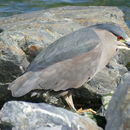Biology
provided by Arkive
The black-crowned night heron is an opportunistic predator, with a varied diet that includes small fish, crabs, crayfish, snakes, amphibians, small rodents, the chicks of other birds, insects and sometimes plant matter (2) (4) (6). Although a gregarious species, individuals generally forage alone, feeding throughout the night from dusk to early morning (2) (3). In the dimly lit hours of night, prey is pinpointed with the help of exceptional eyesight, and retrieved with a swift grasp of the bill (3). However, during the breeding season, when food is in high demand, daytime foraging is also relatively common (2) (4)
Nesting occurs in large colonies, often comprising several different species, and located on islands or other suitable sites where predators pose less of a threat (2). During the breeding season, the male establishes a territory and typically performs a variety of displays to attract a female, including exaggerated bows that accentuate the white neck plumes, bill snapping, and twig shaking (2) (6). Initially the male constructs the nest alone, but following pair formation, the male presents twigs to the female, who in turn works them into the nest. The shallow nest may be located in the branch of a tree or shrub, in a reed bed or even just on the ground (2). Following copulation the female lays three to five greenish eggs, which are incubated by both parent birds for 24 to 26 days before hatching. The young are fed on food regurgitated by the parent birds and fledge after six to seven weeks, sometimes forming small flocks, and may continue to beg for food from the adults (6).
Northern populations of the black-crowned night heron are migratory, travelling south over winter after the breeding season. Conversely, tropical populations, which nest during the rainy season, are largely sedentary, but may also exhibit some dispersal movements post-breeding (4).
Conservation
provided by Arkive
There are no known conservation efforts for the black-crowned night heron at an international level but local conservation groups are working towards preserving declining populations in parts of its range. For instance, in Pennsylvania, where the species has been listed as Endangered following ongoing population declines, several important colonies are now protected (6)
Description
provided by Arkive
Despite being fairly ubiquitous on a global level, the slightly unusual nocturnal habit of the black-crowned night heron renders it less conspicuous than most other herons (2) (3) (4). Of moderate size for a heron, this stockily built species has short legs and a short neck, with the male, on average, being the slightly larger of the sexes (2) (5). As its name suggests, the adult black-crowned night heron has a glossy, black cap that extends down the upper back, while the rest of the body plumage generally ranges from white to ashy grey (2) (5). The nape is adorned with two to three long, white plumes reaching up to 25 cm in the breeding season (5). The stout bill is black in colour, the eyes, a piercing crimson, and the legs, yellow-green for most of the year but becoming pink during the breeding season (2) (5). Juveniles are mostly brown, with heavy striping and pale spots, but as they grow towards the adult plumage, become more solidly dark above and pale below (2). Four subspecies that differ subtly in appearance and occupy different ranges are currently recognised: Nycticorax nycticorax nycticorax, N. n. hoactli, N. n. obscurus and N. n. falkandicus (2) (5).
Habitat
provided by Arkive
Occurs in a broad range of fresh, brackish and salt-water habitats, from rivers, lakes and swamps to lagoons, mudflats, and salt-marsh (2). Aquatic and marginal vegetation such as reed beds, bamboo, mangroves and other trees are important for nesting and roosting (4).
Range
provided by Arkive
The black-crowned night heron breeds on every continent except for Antarctica and Australasia (2).
Status
provided by Arkive
Classified as Least Concern (LC) on the IUCN Red List (1).
Threats
provided by Arkive
Although the black-crowned night heron is still relatively widespread and abundant, localised threats do present a concern for some populations (4). Some of the main threats cited for this species in different parts of its range include habitat loss, wetland degradation, pesticide and petroleum contamination, disease and hunting (2) (4) (6).

